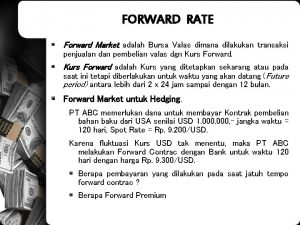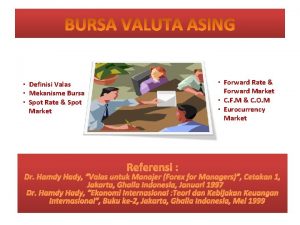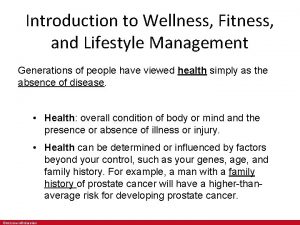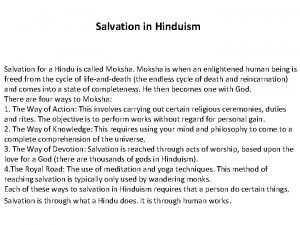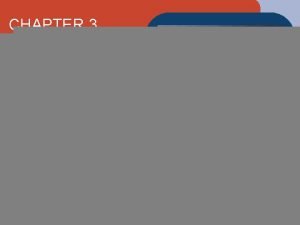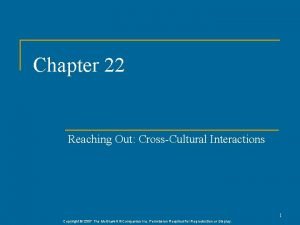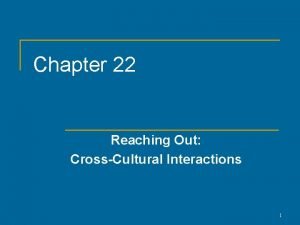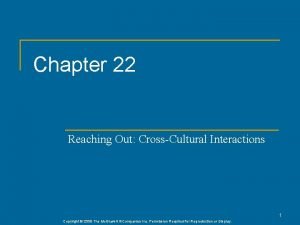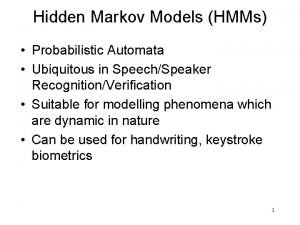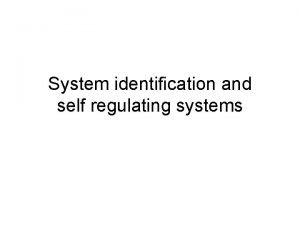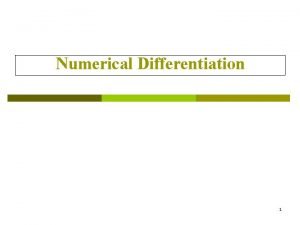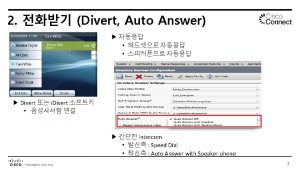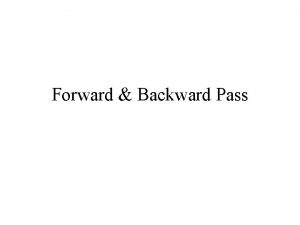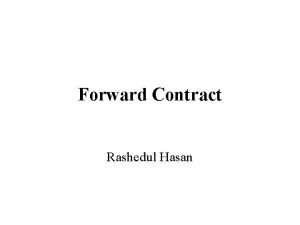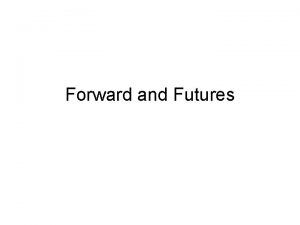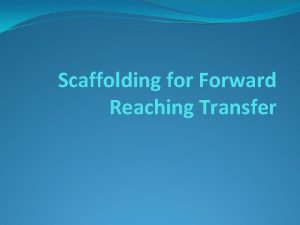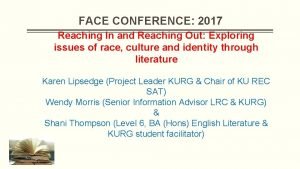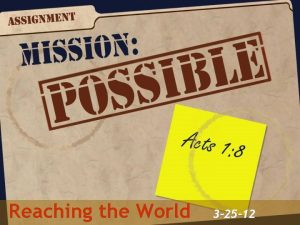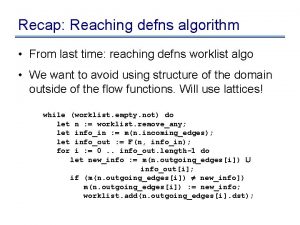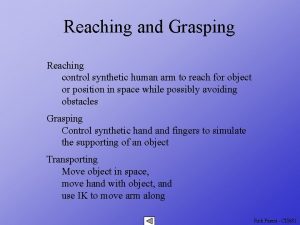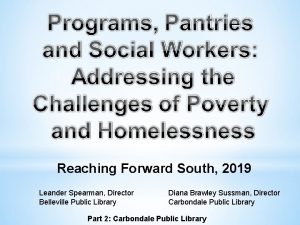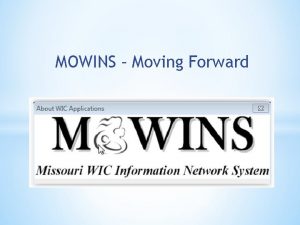Forward Reaching Transfer What is Transfer n Transfer


















- Slides: 18

+ Forward Reaching Transfer

+ What is Transfer? n Transfer is about finding ways of crossing some gap: The learner doing something with what has been learned, under a different set of conditions n Transfer involves “Successful initial learning positively influencing performance on a later occasion and with a different appearance” (Perkins and Salomon)

+ Forward and Backward Reaching Transfer n Backward reaching: Abstracting from prior knowledge to solve current problem n Forward reaching: Abstracting learning for use in later contexts

+ Near and Far Transfer n Near Transfer: Transfer of skills/knowledge across similar contexts n Far Transfer: Transfer of skills/Knowledge across dissimilar contexts

+ Near Transfer, Low Road n Near Transfer involves low road processes: “automatic triggering of well-practiced routines in circumstances where there is considerable perceptual similarity to the original learning context” (Perkins & Salomon) n Unconscious, n Genres n “If habitual, fast thinking (Kahneman) (forms of familiarity) I’ve written a summary of a poem before, then I can write a summary of a novel. ”

+ Far Transfer, High Road n Far transfer involves high road processes: “depends on deliberate, mindful abstraction of skill and knowledge from one context for application to another” (Perkins & Salomon) n Conscious, reflective thought, slow thinking n Meta-cognition: one’s thinking. n “If monitor, inventory, assess, reflect on I’ve written a summary before, then I can write an argument paper. ”

+ How Something is Learned Affects Transfer-ability n Learned as facts v. as solving problems n Understanding n Developing conceptual understanding n Encountering n Learning underlying principles concepts in multiple contexts how to learn while learning

+ Developing Writing Transfer-ability n. Transfer is developed by a student’s vocabulary for discussing and enacting metacognition in their work n. Create space and opportunity for metacognition

+ Teaching for Transfer n. Encouraging reflection on writing process, revision, responding to feedback, etc. n. Assignments and components that explicitly establish metacognition, rhetorical/genre awareness, etc.

+ Teaching for Forward Reaching Transfer n. Reflection n. Writer’s Memos n. Outcome Mapping

+ With other teachers from your school: n What are your students reaching toward? In what specific contexts will the skills of UWHS and its outcomes transfer for your students? In what contexts do your students anticipate that these skills they’re developing will be important? n What are your students’ goals? How might college writing outcomes help them with those goals?

+ With other teachers from your school: n What activities or practices do you already implement in your classroom that develops forward-reaching transfer for the skills included in the outcomes? n What reflective and metacognitive practices have already helped your students to use the outcome skills and concepts in new contexts?

+ With other teachers from your school: n How can you introduce or further develop your assignments or activities in your classroom to support transfer of some of these outcomes for your students? n Which specific activities will help students to reflect throughout their learning on the potential of new skills for diverse contexts?

+ Ideas for Forward Reaching Transfer to COLLEGE!!! n Meg: asking recent graduates to come in to talk about college. n Meg: Brainstorming ideas for getting to their future plans of college. n Stephanie: asking recent graduates – all with different career paths. n Stephanie: habits of mind (desk, quiet space for work, etc. ) – teaching life skills n Sammy: use UWHS-like prompt (and reveal this to students after they’ve been successful at the project). n Share a portfolio of UWHS or from a UW student so they can see “college level” writing.

+ Ideas for Forward Reaching Transfer to COLLEGE!!! n Kristi: Show the outcomes – ask students to re-word. And then ask students to look at it throughout the semester. n Sammy: Finish a unit and then ask them to read the outcomes. Then, have them name which assignments met each outcome. You could also do this continually throughout their years of school – have a tracking list. n Jacki/Olivia: strength/difficulty journal n Eileen: Ask – “If I have experience with these outcomes, am I more prepared for college writing? ” – Need to build confidence in our students.

+ Ideas for Transfer Across Contexts n Sammy/Caron/Kristi: make the knowledge building clear to the students. Signal verbally that writing will help them in with future types of writing. n Roger: building between assignments – ask students to articulate how one assignment will help them with the next assignment. n Sammy: writer’s memo on what you can do better on the next assignment. (and reflecting back on why your grades improve). n

+ Teaching Metacognition n Sammy: Start with simple sentences. Introduce 2 -3 types of sentences. Then, revise them to the new types. n Jen: rubrics – if they get below a certain grade, then re-teach. n Stephanie: not giving the outcomes but instead looking at a rubric and then having them actually determine what outcome it applies to (or what it’s working towards) n Eileen: transferring ideas – teach an idea and then the student writing doesn’t really reflect their knowledge, so you ask them to revise (but they don’t really). Instead, ask students to do work that doesn’t allow memorization but learning in the moment. So, for the revision – ask them to revise and then explain their choices.

+ Thank you!
 Forgetting those things which are behind
Forgetting those things which are behind Forward rate dan forward market
Forward rate dan forward market Forward market
Forward market When i found the joy of reaching your heart
When i found the joy of reaching your heart Introduction to wellness and fitness
Introduction to wellness and fitness Salvation in hinduism
Salvation in hinduism Reaching global markets
Reaching global markets Strategies for reaching global markets
Strategies for reaching global markets Reaching out from within
Reaching out from within Reaching for the infinite heart
Reaching for the infinite heart Chapter 22 reaching out cross-cultural interactions
Chapter 22 reaching out cross-cultural interactions Reaching beyond yourself
Reaching beyond yourself Chapter 22 reaching out cross-cultural interactions
Chapter 22 reaching out cross-cultural interactions Chapter 22 reaching out cross-cultural interactions
Chapter 22 reaching out cross-cultural interactions Transfer transfer
Transfer transfer Forward algorithm
Forward algorithm Backward rectangular rule
Backward rectangular rule Numerical derivative example
Numerical derivative example Forward freight agreement definition
Forward freight agreement definition

